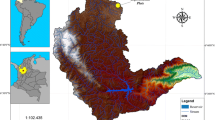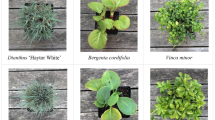Abstract
Long term studies have shown strong links between vegetation clearing and rainfall declines and more intense droughts. Many agroecosystems are exposed to more extreme weather and further declines in rainfall under climate change unless adaptations increase the retention of water in landscapes, and its recycling back to the lower atmosphere. Vegetation systems provide vital feedbacks to mechanisms that underpin water vapour recycling between micro- and meso-scales. Various heterogeneous forms of vegetation can help generate atmospheric conditions conducive to precipitation, and therefore, increase the resilience of agroecosystems to drought and climatic extremes. The aim of this paper is to demonstrate how vegetation can be designed for agroecosystems to enhance recycling of water vapour to the atmosphere through the regulation of surface water and wind, and heat fluxes. The structure of the paper revolves around five functions of integrated vegetation designs that can help underpin the restoration of water recycling through enhanced retention of stormwater, protection from wind, moistening and cooling the landscape, production of plant litter, and contribution toward regional scale climate and catchment functioning. We also present two supplementary functions relevant to land and natural resource managers which may also be integrated using these designs.


Similar content being viewed by others
References
Abel N, Baxter J, Campbell A, Cleugh H, Fargher J, Lambeck RJ, Prinsley R, Prosser M, Reid R, Revell G, Schmidt C, Stirzaker R, Thorburn P (1997) Design principles for farm forestry: a guide to assist farmers to decide where to place trees and farm plantations on farms. ACT, Rural Industries Research and Development Corporation, Barton
Andreae MO, Rosenfeld D (2008) Aerosol-cloud-precipitation interactions. Part 1. The nature and sources of cloud-active aerosols. Earth-Sci Rev 89(1–2):13–41
Anthes RA (1984) Enhancement of convective precipitation by mesoscale variations in vegetative covering in semiarid regions. J Clim Appl Meteorol 23(4):541–554
Balieiro FD, Pereira MG, Alves BJR, de Resende AS, Franco AA (2008) Soil carbon and nitrogen in pasture soil reforested with eucalyptus and guachapele. Revista Brasileira De Ciencia Do Solo 32(3):1253–1260
Bardgett R (2005) The biology of soil: a community and ecosystem approach. Oxford University Press, Oxford
Bari MA, Smettem KRJ, Sivapalan M (2005) Understanding changes in annual runoff following land use changes: a systematic data-based approach. Hydrol Process 19(13):2463–2479
Bathgate A, Seddon J and Hacker R (2008) Managing catchments for multiple objectives: the implications of land use change for salinity, biodiversity and economics. 2nd International salinity forum: salinity, water and society–global issues, local action. Adelaide
Bird P (1998) Tree windbreaks and shelter benefits to pasture in temperate grazing systems. Agrofor Syst 41:35–54
Bird PR, Bicknell D, Bulman PA, Burke SJA, Leys JF, Parker JN, Sommen FJ, Voller P (1992) The role of shelter in Australia for protecting soils, plants and livestock. Agrofor Syst 20(1):59–86
Bonan GB (2002) Ecological climatology: concepts and applications. Cambridge, Cambridge
Boody G, Vondracek B, Andow DA, Krinke M, Westra J, Zimmerman J, Welle P (2005) Multifunctional agriculture in the United States. Bioscience 55(1):27–38. doi:10.1641/0006-3568(2005)055[0027:MAITUS]2.0.CO;2
Borsboom AC, Wang J, Lees N, Mathieson M, Hogan L (2002) Measurement and integration of fauna biodiversity values in Queensland agroforestry systems. Joint Venture Agroforestry Program, Rural Industries Research and Development Corporation, Canberra
Bosch JM, Hewlett JD (1982) A review of catchment experiments to determine the effect of vegetation changes on water yield and evapotranspiration. J Hydrol 55(1–4):3–23
Bregman L (1993) Comparison of the erosion control potential of agroforestry systems in the Himalayan region. Agrofor Syst 21(2):101–116
Brown ME, Arnold DL (1998) Land-surface-atmosphere interactions associated with deep convection in Illinois. Int J Climatol 18(15):1637–1653
Calder IR (2007) Forests and water—ensuring forest benefits outweigh water costs. For Ecol Manage 251(1–2):110–120
Cammeraat ELH (2004) Scale dependent thresholds in hydrological and erosion response of a semi-arid catchment in southeast Spain. Agric Ecosyst Environ 104(2):317–332
Campbell A (2008) Managing Australian landscapes in a changing climate: a climate change primer for regional natural resource management bodies. Department of Climate Change, Canberra
Chahinian N, Moussa R, Andrieux P, Voltz M (2006) Accounting for temporal variation in soil hydrological properties when simulating surface runoff on tilled plots. J Hydrol 326(1–4):135–152
Christner BC, Morris CE, Foreman CM, Cai R, Sands DC (2008) Ubiquity of biological ice nucleators in snowfall. Science 319(5867):1214. doi:10.1126/science.1149757
Cleugh H (1998) Effects of windbreaks on airflow, microclimates and crop yields. Agrofor Syst 41(1):55–84
Cleugh H (2003) Trees for shelter: a guide to using windbreaks on Australian farms. RIRDC, Canberra
Cleugh HA, Hughes DE (2002) Impact of shelter on crop microclimates: a synthesis of results from wind tunnel and field experiments. Aust J Exp Agric 42(6):679–701
Courault D, Drobinski P, Brunet Y, Lacarrere P, Talbot C (2007) Impact of surface heterogeneity on a buoyancy-driven convective boundary layer in light winds. Boundary-Layer Meteorol 124(3):383–403
Diehl K, Quick C, Matthias-Maser S, Mitra SK, Jaenicke R (2001) The ice nucleating ability of pollen: part I: laboratory studies in deposition and condensation freezing modes. Atmos Res 58(2):75–87
Dlamini TC, Haynes RJ (2004) Influence of agricultural land use on the size and composition of earthworm communities in northern KwaZulu-Natal, South Africa. Appl Soil Ecol 27(1):77–88
Eamus D, Macinnis-Ng CMO, Hose GC, Zeppel MJB, Taylor DT, Murray BR (2005) Ecosystem services: an ecophysiological examination. Aust J Bot 53(1):1–19
Easterling DR, Meehl GA, Parmesan C, Changnon SA, Karl TR, Mearns LO (2000) Climate extremes: observations, modeling, and impacts. Science 289(5487):2068–2074. doi:10.1126/science.289.5487.2068
Fabrizzi KP, Rice CW, Amado TJC, Fiorin J, Barbagelata P, Melchiori R (2009) Protection of soil organic C and N in temperate and tropical soils: effect of native and agroecosystems. Biogeochemistry 92(1–2):129–143
Falkenmark M, Rockstrom J (2004) Balancing water for humans and nature: the new approach in ecohydrology. Earthscan Publications, London
Fischer J, Lindenmayer DB, Manning AD (2006) Biodiversity, ecosystem function, and resilience: ten guiding principles for commodity production landscapes. Front Ecol Environ 4(2):80–86. doi:10.1890/1540-9295(2006)004[0080:BEFART]2.0.CO;2
Fitter AH, Gilligan CA, Hollingworth K, Kleczkowski A, Twyman RM, Pitchford JW (2005) Biodiversity and ecosystem function in soil. Funct Ecol 19(3):369–377
Fohrer N, Haverkamp S, Frede HG (2005) Assessment of the effects of land use patterns on hydrologic landscape functions: development of sustainable land use concepts for low mountain range areas. Hydrol Process 19(3):659–672
Garnaut R (2008) Garnaut climate change review. Commonwealth of Australia, Canberra
Geddes N, Dunkerley D (1999) The influence of organic litter on the erosive effects of raindrops and of gravity drops released from desert shrubs. CATENA 36(4):303–313
Gordon L, Dunlop M, Foran B (2003) Land cover change and water vapour flows: learning from Australia. Philos Trans Biol Sci 358(1440):1973–1984
Gordon LJ, Steffen W, Jonsson BF, Folke C, Falkenmark M, Johannessen A (2005) Human modification of global water vapor flows from the land surface. Proc Natl Acad Sci USA 102(21):7612–7617. doi:10.1073/pnas.0500208102
Greene RSB, Hairsine PB (2004) Elementary processes of soil-water interaction and thresholds in soil surface dynamics: a review. Earth Surf Process Landf 29(9):1077–1091
Guo Z, Xiao X, Li D (2000) An assessment of ecosystem services: water flow regulation and hydroelectric power production. Ecol Appl 10(3):925–936
Hairsine PB, van Dijk AIJM (2006) Comparing the in-stream outcomes of commercial and environmental tree plantings. CSIRO Land and Water, Canberra, Australia
Harms BP, Dalal RC, Cramp AP (2005) Changes in soil carbon and soil nitrogen after tree clearing in the semi-arid rangelands of Queensland. Aust J Bot 53(7):639–650
Harris J (2009) Soil microbial communities and restoration ecology: facilitators or followers? Science 325:573–574
Hayden BP (1998) Ecosystem feedbacks on climate at the landscape scale. Philos Trans R Soc Lond Ser B-Biol Sci 353:5
Hazra A, Saha M, De UK, Mukherjee J, Goswami K (2004) Study of ice nucleating characteristics of Pseudomonas aeruginosa. J Aerosol Sci 35(11):1405–1414
Hook PB (2003) Sediment retention in rangeland riparian buffers. J Environ Qual 32(3):1130–1137
Hussein J, Ghadiri H, Yu B, Rose C (2007) Sediment retention by a stiff grass hedge under subcritical flow conditions. Soil Sci Soc Am J 71(5):1516–1523
Jackson ST, Hobbs RJ (2009) Ecological restoration in the light of ecological history. Science 325(5940):567–569. doi:10.1126/science.1172977
Judd MJ, Raupach MR, Finnigan JJ (1996) A wind tunnel study of turbulent flow around single and multiple windbreaks, part I. Velocity fields. Boundary-Layer Meteorol 80(1–2):127–165
Kravcík M, Pokorný J, Kohutiar J, Kovác M, Tóth E (2007) Water for the recovery of the climate—a new water paradigm. Bratislava, Slovakia. http://waterparadigm.org/
Lal R (1993) Soil erosion and conservation in West Africa. In: Pimentel D (ed) World soil erosion and conservation. Cambridge, Cambridge Univeristy Press, pp 7–25
Lane PNJ, Hairsine PB, Croke JC, Takken I (2006) Quantifying diffuse pathways for overland flow between the roads and streams of the mountain ash forests of central Victoria Australia. Hydrol Process 20(9):1875–1884
Lehmann J (2007) A handful of carbon. Nature 447(7141):143–144
Lehmann J, Gaunt J, Rondon M (2006) Bio-char sequestration in terrestrial ecosystems: a review. Mitig Adapt Strat Glob Change 11:395–419
Leys J, McTainsh G (1994) Soil loss and nutrient decline by wind erosion—cause for concern. Aust J Soil Water Conserv 7(3):30–35
Li X, Wilson SD (1998) Facilitation among woody plants establishing in an old field. Ecology 79(8):2694–2705
Lindenmayer DB, Hobbs RJ, Salt D (2003) Plantation forests and biodiversity conservation. Aust For 66(1):62–66
Liu QQ, Singh VP (2004) Effect of microtopography, slope length and gradient, and vegetative cover on overland flow through simulation. J Hydrol Eng 9(5):375–382
Lott JE, Khan AAH, Ong CK, Black CR (1995) Sap flow measurements of lateral tree roots in agroforestry systems. In: International symposium on dynamics of physiological processes in Woody Roots, Ithaca, New York
Lynn BH, Tao W-K, Wetzel PJ (1998) A study of landscape-generated deep moist convection. Mon Weather Rev 126:928–942
Mahfouf JF, Richard E, Mascart P (1987) The influence of soil and vegetation on the development of mesoscale circulations. J Clim Appl Meteorol 26(11):1483–1495
Mander Ü, Wiggering H, Helming K (2007) Multifunctional land use: meeting future demands for landscape goods and services. In: Mander Ü, Kull A, Dalgaard T, Piorr A, Happe K (eds) Multifunctional land use: meeting future demands for landscape goods and services. Berlin, Springer, pp 1–13
McAlpine CA, Fensham RJ, Temple-Smith DE (2002) Biodiversity conservation and vegetation clearing in Queensland: principles and thresholds. Rangeland J 24(1):36–55
McAlpine CA, Syktus J, Ryan JG, Deo RC, McKeon GM, McGowan HA, Phinn SR (2009) A continent under stress: interactions, feedbacks and risks associated with impact of modified land cover on Australia’s climate. Glob Change Biol 15:2206–2223
McAlpine CA, Seabrook L, Rhodes JR, Maron M, Bowen ME, Price B, Powell O, Ryan JG, Fyfe CT, Butler S, Adams-Hosking CM, Smith A, Robertson O, Cattarino L (this edition) How do we make landscape ecology an integrated, problem solving science? Landscape Ecol
McKeon GM, Chilcott C, McGrath W, Paton C, Fraser G, Stone GS, Ryan JG (2008) Assessing the value of trees in sustainable grazing systems. Meat and Livestock Australia, Brisbane
McKeon GM, Stone GS, Syktus JI, Carter JO, Flood NR, Ahrens DG, Bruget DN, Chilcott CR, Cobon DH, Cowley RA, Crimp SJ, Fraser GW, Howden SM, Johnston PW, Ryan JG, Stokes CJ, Day KA (2009) Climate change impacts on northern Australian rangeland livestock carrying capacity: a review of issues. In: 15th Conference of the Australian-rangeland-society, Queensland, Australia, Australian Rangeland Soc
McNeely J, Schroth G (2006) Agroforestry and biodiversity conservation–traditional practices, present dynamics, and lessons for the future. Biodivers Conserv 15(2):549–554
Millar CI, Stephenson NL, Stephens SL (2007) Climate change and forests of the future: managing in the face of uncertainty. Ecol Appl 17(8):2145–2151. doi:10.1890/06-1715.1
Mohler O, DeMott PJ, Vali G, Levin Z (2007) Microbiology and atmospheric processes: the role of biological particles in cloud physics. Biogeosciences 4(6):1059–1071
Mohr KI, David Baker R, Tao W-K, Famiglietti JS (2003) The sensitivity of West African convective line water budgets to land cover. J Hydromet 4:62–76
Nair PKR, Kumar BM, Nair VD (2009) Agroforestry as a strategy for carbon sequestration. J Plant Nutr Soil Sci-Z Pflanzenernahr Bodenkd 172(1):10–23. doi:10.1002/jpln.200800030
Nuberg IK (1998) Effect of shelter on temperate crops: a review to define research for Australian conditions. Agrofor Syst 41(1):3–34
O’Loughlin EM, Nambiar EKS (2001) Plantations, farm forestry and water—a discussion paper. Rural Industries Research and Development Corporation, Canberra
Oki T, Kanae S (2006) Global hydrological cycles and world water resources. Science 313:1068–1072
Olechowicz E (2007) Soil and litter macrofauna in shelterbelts and in adjacent croplands: changes in community structure after tree planting. Pol J Ecol 55(4):647–664
Ong CK, Black CR, Wallace JS, Khan AAH, Lott JE, Jackson NA, Howard SB, Smith DM (2000) Productivity, microclimate and water use in Grevillea robusta-based agroforestry systems on hillslopes in semi-arid Kenya. Agric Ecosyst Environ 80(1–2):121–141
Osborne TM, Lawrence DM, Slingo JM, Challinor AJ, Wheeler TR (2004) Influence of vegetation on the local climate and hydrology in the tropics: sensitivity to soil parameters. Clim Dyn 23(1):45–61
Pal JS, Eltahir EAB (2001) Pathways relating soil moisture conditions to future summer rainfall within a model of the land-atmosphere system. J Clim 14(6):1227
Paul KI, Polglase PJ, O’Connell AM, Carlyle JC, Smethurst PJ, Khanna PK, Worledge D (2003) Soil water under forests (SWUF): a model of water flow and soil water content under a range of forest types. For Ecol Manage 182(1–3):195–211
Paz-Ferreiro J, Bertol I, Vidal Vazquez E (2008) Quantification of tillage, plant cover, and cumulative rainfall effects on soil surface microrelief by statistical, geostatistical and fractal indices. Nonlinear Process Geophys 15(4):575–590
Pielke RA (2001) Influence of the spatial distribution of vegetation and soils on the prediction of cumulus convective rainfall. Rev Geophys 39(2):151–177
Pielke RA, Adegoke J, Bentran-Przekurat A, Hiemstra CA, Lin J, Nair US, Niyogi D, Nobis TE (2007) An overview of regional land-use and land-cover impacts on rainfall. Tellus B 59(3):587–601
Post DA, Bartley R, Corfield J, Nelson B, Kinsey-Henderson A, Hawdon A, Gordon I, Abbott B, Berthelsen S, Hodgen M, Keen R, Kemei J, Vleeshouwer J, MacLeod N, Webb M (2006) Sustainable grazing for a healthy Burdekin catchment. CSIRO Land and Water, Canberra
Prabha T, Karipot A, Binford M (2007) Characteristics of secondary circulations over an inhomogeneous surface simulated with large-eddy simulation. Boundary-Layer Meteorol 123(2):239–261
Qin F, Yu X, Zhang M, Xie Y (2005) Mechanism of watershed soil erosion control by vegetation. Chin J Appl Ecol 16(9):1618–1622
Rachman A, Anderson SH, Gantzer CJ, Thompson AL (2004) Influence of stiff-stemmed grass hedge systems on infiltration. Soil Sci Soc Am J 68(6):2000–2006
Ruel J-C, Pin D, Cooper K (1998) Effect of topography on wind behaviour in a complex terrain. Forestry 71(3):261–265
Rutherford I (2000) Some human impacts on Australian stream channel morphology. In: Brizga SO, Finlayson BL (eds) River management: an Australasian experience. Wiley, Chichester, England, pp 11–49
Ryan JG (2007) Combining farmer decision making with systems models for restoring multi-functional ecohydrological systems in degraded catchments. Department of Geography and Planning, The University of Queensland, Brisbane, p 202
Ryan JG, Ludwig JA, McAlpine CA (2007) Complex adaptive landscapes (CAL): a conceptual framework of multi-functional, non-linear ecohydrological feedback systems. Ecol Complex 4(3):113–127
Savenije HHG (1995) New definitions for moisture recycling and the relationship with land-use changes in the Sahel. J Hydrol 167(1–4):57–78
Schoeneberger MM (2005) Agroforestry: working trees for sequestering carbon on agricultural lands. In: 9th North American agroforestry conference. Springer, Rochester, MN
Steffen WL (2009) Climate change 2009: faster change and more serious risks. Commonwealth Government of Australia, Canberra
Stohlgren TJ, Chase TN, Pielke RA, Kittel TGF, Baron JS (1998) Evidence that local land use practices influence regional climate, vegetation, and stream flow patterns in adjacent natural areas. Glob Chang Biol 4(5):495–504
Thomas GW, Haszler GR, Blevins RL (1996) The effects of organic matter and tillage on maximum compactability of soils using the Protor test. Soil Sci 161(8):502–508
Vali G, Christensen M, Fresh RW, Galyan EL, Maki LR, Schnell RC (1976) Biogenic ice nuclei. Part II: bacterial sources. J Atmos Sci 33(8):1565–1570
Vergé XPC, De Kimpe C, Desjardins RL (2007) Agricultural production, greenhouse gas emissions and mitigation potential. Agric For Meteorol 142(2–4):255–269
Wallingford HR (2004) Guidelines for predicting and minimising sedimentation in small dams. HR Wallingford, Wallingford, UK
Walsh PG, Barton CVM, Haywood A (2008) Growth and carbon sequestration rates at age ten years of some eucalypt species in the low- to medium-rainfall areas of New South Wales, Australia. Aust For 71(1):70–77
Wilson BR, Growns I, Lemon J (2008) Land-use effects on soil properties on the north-western slopes of New South Wales: implications for soil condition assessment. Aust J Soil Res 46(4):359–367
Young R, Wilson BR, McLeod M, Alston C (2005) Carbon storage in the soils and vegetation of contrasting land uses in northern New South Wales, Australia. Aust J Soil Res 43(1):21–31
Zhang J-t, Su X-h (2008) Numerical model for flow motion with vegetation. J Hydrodyn Ser B 20(2):172–178
Author information
Authors and Affiliations
Corresponding author
Rights and permissions
About this article
Cite this article
Ryan, J.G., McAlpine, C.A. & Ludwig, J.A. Integrated vegetation designs for enhancing water retention and recycling in agroecosystems. Landscape Ecol 25, 1277–1288 (2010). https://doi.org/10.1007/s10980-010-9509-7
Received:
Accepted:
Published:
Issue Date:
DOI: https://doi.org/10.1007/s10980-010-9509-7




